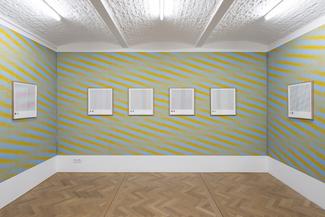
Wave Patterns Adrien Lucca
Dates : Mardi 19 avril 2016 - Samedi 28 mai 2016
Vernissage : Vernissage mar 19 avr 2016, 19:00
Adresse : LEVY.DELVAL, rue fourmoisstraat 9, 1050 Bruxelles
LEVY.DELVAL
rue fourmoisstraat 9
1050 Bruxelles
Belgique
Description, horaires...
On white paper sheets, grids of little colored squares are painted. For every composition, the two juxtaposed colors are complementary and the proportion of each color is calculated for the optical average of the grid to be a grey. The local probability for a square of the grid to be of one or of the other color is determined by two superimposed sinusoidal waves, whose frequency and direction are randomly chosen. The complementary colors amplify themselves mutually when we look closely at them: a light yellow is more light and more yellow next to a dark blue-violet and vice-versa. However, the resulting color of the patterns is light, balanced, and a bit faded by the paper whiteness.
Because the colors of the compositions interact with each other and with the colors on the walls, the pieces were placed in a random order. There was no good reason for any of them to be next to another one in particular. The two colors used in every piece were used only once in the series.